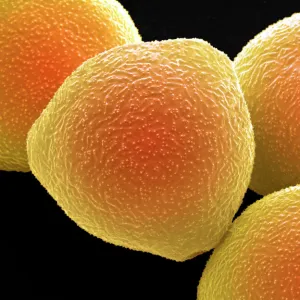Home > Science > SEM
Primrose pollen, SEM
![]()

Wall Art and Photo Gifts from Science Photo Library
Primrose pollen, SEM
Primrose pollen. Coloured scanning electron micrograph (SEM) of pollen grains (pink) from a primrose flower (Primula vulgaris). The pollen shows the round, sculpted protein coat characteristic of primroses. Pollen is produced by the male sex organs in primrose flowers and dispersed by insects to the female sex organs where the eggs are fertilised. Species of the Primula genus have evolved so that two types of hermaphrodite flower are produced and an individual plant only produces one type. The difference in structure between the two flower types favours cross-pollination. Self-pollination tends to produce less viable seeds
Science Photo Library features Science and Medical images including photos and illustrations
Media ID 6287131
© SUSUMU NISHINAGA/SCIENCE PHOTO LIBRARY
False Colour Fertilisation Fertilization Gamete Gametes Plant Anatomy Pollen Pollen Grain Pollen Grains Pollination Primrose Primula Primula Vulgaris Re Production Reproductive Sex Cell Cells Cross Pollination False Coloured
EDITORS COMMENTS
This print showcases the intricate beauty of primrose pollen. Taken through a scanning electron microscope (SEM), the image reveals pink-hued pollen grains from a Primula vulgaris flower. The round shape and sculpted protein coat are distinctive features of primroses. Pollen plays a crucial role in plant reproduction, being produced by the male sex organs in primrose flowers. Insects serve as vital pollinators, carrying these grains to the female sex organs where fertilization occurs, leading to egg development. Interestingly, species within the Primula genus have evolved to produce two types of hermaphrodite flowers, with each individual plant only producing one type. The structural differences between these flower types promote cross-pollination rather than self-pollination since it results in more viable seeds. This adaptation ensures genetic diversity and enhances overall reproductive success for primroses. Displayed here is not just an artistic representation but also a scientific marvel captured by advanced microscopy techniques. The false coloring adds depth and visual appeal to this SEM image, allowing us to appreciate the microscopic world within plants. This photograph serves as a reminder of nature's intricate mechanisms at work and highlights the importance of pollinators in maintaining biodiversity among flowering plants like primroses.
MADE IN THE UK
Safe Shipping with 30 Day Money Back Guarantee
FREE PERSONALISATION*
We are proud to offer a range of customisation features including Personalised Captions, Color Filters and Picture Zoom Tools
SECURE PAYMENTS
We happily accept a wide range of payment options so you can pay for the things you need in the way that is most convenient for you
* Options may vary by product and licensing agreement. Zoomed Pictures can be adjusted in the Basket.




